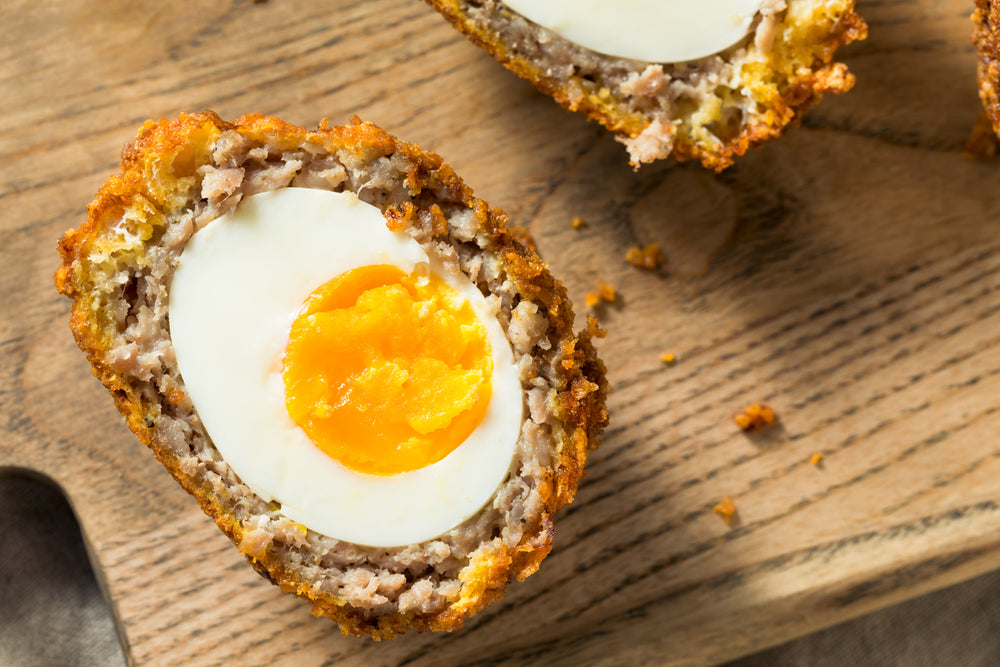Scotch eggs are a traditional British dish that comprises of boiled eggs (shells removed) wrapped in sausage meat, wrapped in breadcrumbs, and then deep-fried. It is quite a popular dish in the pubs and commonly packed for picnics. The British like to savour it cold. It is also easily available in most food shops and grocery stores all across the UK.
A History of Scotch Eggs

While the dish has been a part of British cuisine for a long time, the origins of scotch eggs are much debated.
Fortnum & Mason of Piccadilly, a department store in London that was established in 1738, says that they were the first to have created and served scotch eggs to travelers on carriage rides.
However, the first recipe for scotch eggs is found in a book named New System of Domestic Cookery, published in 1809 written by Maria Rundell. The dish has been referred to as Scotties, and instead of sausage meat, they were covered in a creamy paste, sprinkled with breadcrumbs, and then deep fried. The dish got its name from Scotties because they were made by William J Scott & Sons, an eatery that was located close to the seafront.
It is often said that scotch eggs are inspired by an Indian dish, Nargisi Kofta – egg covered in minced meat and then served with curry). The returning British soldiers introduced it to Britain.
Irrespective of its origin, scotch eggs continue to be a popular dish that the British love to eat as a snack.
Let us unfold some important tips and tricks to help you make perfect scotch eggs:
Quality Ingredients
Using good quality ingredients enhances the taste of any dish. When it comes to scotch eggs, the sausage meat and the breadcrumbs used should be of good quality. In the period of World War II, people lost an appetite for scotch eggs because the quality of breadcrumbs had deteriorated. Hence, remember to buy quality ingredients for the dish.
Boil them Right
Scotch eggs can be enjoyed in cold or warm/normal temperatures. They are sometimes served with a runny yolk and sometimes firm. Hence, the eggs must be boiled according to the way one would like the yolk.

Runny Yolk Scotch Eggs – The eggs should be boiled for 4 minutes.
Firm Yolk Scotch Eggs – The eggs should be boiled for 10 minutes, transferred to cold water, and then you should proceed to make the dish.
Season the Sausage Meat and Breadcrumbs
The sausage meat should be well-seasoned. You can use your choice of seasoning. Remember to add seasoning to the breadcrumbs, too, as it is the first layer you will put into.
Assemble the Eggs and Meat
When you layer the egg with the sausage meat, remember to coat it evenly, ensuring no gaps or cracks. If the coating is not done properly, oil tends to seep inside the dish when deep frying, causing it to crack open.
Right Way of Breading
Before the prepared eggs can be covered in breadcrumbs, you must roll them in flour to create a dry surface – this also makes the egg covered in meat more manageable. Next, dip them in beaten egg and roll in breadcrumbs. If you like a thick breading, dip the prepared egg in the beaten egg again and roll it on the breadcrumbs. Use your palm and fingers to give it a clean shape.
Chill them in the Refrigerator
You must let the prepared scotch eggs rest in the refrigerator for at least 30 minutes. This way, the sausage meat, and the crumbs get firmer, and they are less likely to burst open when frying them.
Frying the Scotch Eggs

The perfect temperature for frying scotch eggs is 175°C or 350°F. You must fry the chilled scotch eggs in hot oil for about 6-8 minutes. They should turn deep golden brown before you remove them from the oil.
Drain the Excess Oil
Place the fried scotch eggs on a plate lined with paper towels for absorbing the excess oil.
Serving

Scotch eggs can be served either warm or cold. You can cut them in half to reveal the delicious layers that you meticulously put together. Different accompaniments go with this dish – every individual has their own taste and way of eating scotch eggs. Some of the common accompaniments include:
Chips – The most simple yet tastiest side dish to serve along with scotch eggs is chips. Coat them with your favourite herbs and seasoning and bake them or air fry them for a healthier version.
Baked Beans – Pour a generous amount of baked beans covered in tomato sauce for a satisfying and protein-filled snack.
Salads – Scotch eggs can be served with almost any type of salad. Tomatoes, cucumber, lettuce, onion, olives, green beans, radish – mix in all your favourite vegetables and delve in with scotch eggs.
Barbecue Sauce – A drizzle of this simple sauce can elevate the taste of scotch eggs.
English Mustard – What better than to dip your scotch eggs in mustard for a nice, delightful taste!
Cold Meat Cuts – Chicken, ham, bacon, beef, pork – it could be anything that suits your palette.
Pickles – Cornichons, gherkins, carrots, and cauliflowers there are so many different varieties of pickles that go with scotch eggs.
Mashed Potato – A steaming bowl of mashed potato is the best comfort food that you can think of. Serve it with scotch eggs to experience an interesting mix of taste and textures. You must not miss this side dish, especially if you are keeping the yolk runny!
Onion Rings – This combination makes really cool finger food when you have a gathering at home. They taste equally good even when cold, so you don't have to worry about keeping them warm.
Conclusion

Scotch eggs are a delightful dish that is served in a variety of unique ways. You just need to ensure you cook them right for a beautiful presentation!


 Easter 2026
Easter 2026
 Frozen Food
Frozen Food
 Baking
Baking
 Beans, Peas, Soups & Tins
Beans, Peas, Soups & Tins
 Biscuits, Crackers & Cookies
Biscuits, Crackers & Cookies
 Candy / Sweets
Candy / Sweets
 Crisps & Snacks
Crisps & Snacks
 Chemist / Pharmacy
Chemist / Pharmacy
 Desserts
Desserts
 Gravy, Stock & Paste
Gravy, Stock & Paste
 Haggis
Haggis
 Indian Sauces, Paste and Pickle
Indian Sauces, Paste and Pickle
 Jams & Preserves
Jams & Preserves
 Poppy Appeal
Poppy Appeal
 Pot Noodles & Super Noodles
Pot Noodles & Super Noodles
 Scone Mix
Scone Mix
 Gluten-Free / Free From
Gluten-Free / Free From
 Tea Accessories
Tea Accessories
 Teapot & Tea sets
Teapot & Tea sets
 Tea For One
Tea For One
 Sugar & Creamer
Sugar & Creamer
 Tableware
Tableware
 Serveware
Serveware
 Plates & Trays
Plates & Trays
 Bowls
Bowls
 Cups & Saucers
Cups & Saucers
 Mugs
Mugs
 Silverware
Silverware
 Dinnerware - Accessories
Dinnerware - Accessories
 Dinnerware - For Pets
Dinnerware - For Pets
 Victoria Eggs - Hand-Drawn UK Homeware
Victoria Eggs - Hand-Drawn UK Homeware
 Jewelry & Accessories
Jewelry & Accessories
 Sale
Sale
 Christmas Gifts
Christmas Gifts

